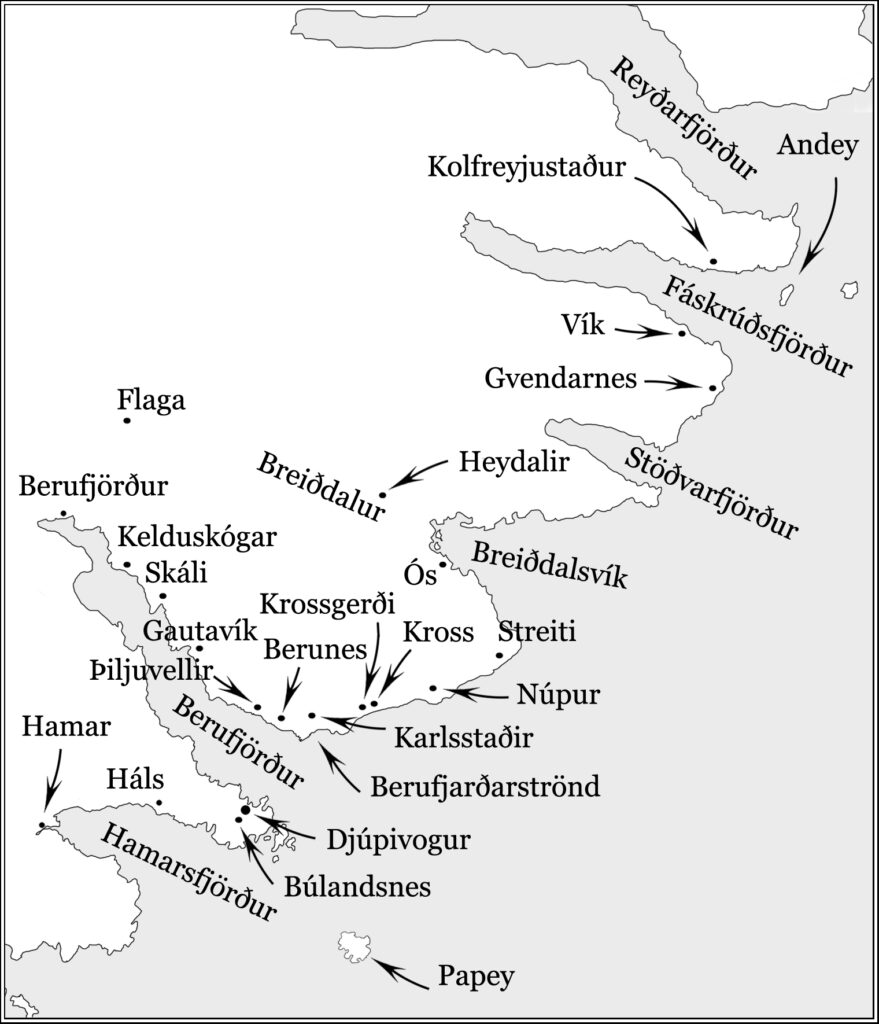This week, we continue with a series of excerpts from Enslaved: The Story of the Barbary Corsair Raid on East Iceland in 1627, the book my Icelandic colleague, Karl Smári Hreinsson, and I recently published.
Here is this week’s excerpt (What follows, remember, is a translation of a four-hundred-year-old document, so a bit of background explanation is sometimes required; we have done this with footnotes. We have also added clarifications in the text in square brackets where needed.)
On July 6, very early in the day, the two Turkish ships[1] were seen from the island of Papey. They had a following wind, and they sailed into the fjord known as Berufjörður. On their way, they encountered four Danish men from the market town of Djúpivogur, in a boat, with their lines out, fishing. The pirates took that boat.
They then followed the usual sailing route of the English into the fjord.[2] When they came abreast of Berunes [on the fjord’s northeast shore] , they dropped their anchors. [See the Map below for the location of Berufjörður and Djúpivogur. See the image above for a depiction of the corsair ships at anchor in Berufjörður.] By this time, it was close to sunrise.

They next rowed over in three boats to the town of Djúpivogur, which is across from Berunes at the southwest end of the fjord. One of the pirates’ boats went quickly towards the Danish merchant ship [that was moored in the harbor at Djúpivogur]. The others went to the two ends of the harbor and surrounded the trading post. [3] The Danish men were all asleep in their beds, both those onboard the ship and on land.
The pirates surprised them and took a total of fifteen men, including an Icelander who was with the Danes. Nobody escaped. The Turks bound them all and transported them in two boats to their ships.
After this, thirty-five pirates armed themselves and went to Búlandsnes farmstead, next to Djúpivogur, screaming and roaring like lions. [See the map below for the location of Búlandsnes farmstead and the other places mentioned.]

They captured Guttormur Hallsson, the master of the farm, and five of his people—a young man, three old women, and a girl—as well as six beggars, who had come there from another area in hopes of receiving food, and also a married couple who were tenant farmers. The Turks tied the hands of the men behind their backs, and a couple of them took the captives to Djúpivogur, from where they were ferried out to the Danish merchant ship.
The remaining thirty-three pirates marched to Háls [a farmstead, with its own chapel, that was located 2 miles/3 kilometers northwest of Búlandsnes]. The pastor there was named Reverend Jón Þorvarðsson. He and all his people were out at the sel [a sort of shepherd’s hut where Icelandic farmers took their livestock in the summer to graze].
The pirates searched everywhere thereabouts, and eventually they discovered the sel. They captured Reverend Jón and his wife, Katrín Þorláksdóttir, along with six local people and also three men who were tenant farmers. They drove all these captives towards Berufjörður farmstead, at the end of the fjord. The priest and his wife were exhausted from the march and from grief and hardship.
The Berufjörður farm folk had been warned about the corsairs’ attack by a boy who escaped from Háls, and they fled to safety with the boy northeast across the mountains into the area called Breiðdalur.[4] The master of Berufjörður farm, Magnús Þórðarson, was some distance away in the countryside.
The pirates told Reverend Jón Þorvarðsson, his wife, and the other captives to wait where they were [under guard]. Then the raiders continued on along the eastern shore of Berufjörður towards Berunes [where their ships were anchored].
For a further excerpt from Enslaved, see the next post here in this blog.
____________________
[1] Seventeenth century Icelanders—and Europeans in general—referred to all Muslims as ‘Turks,’ whether they actually came from geographical Turkey or not.
[2] The Icelandic cod fishery was a major commercial enterprise for the English during this period, as important to their economy as the fisheries of the Grand Banks off Newfoundland. In 1627, no less than 150 English fishing vessels sailed to Iceland for the season. Mostly, they frequented the rich fishing grounds off Iceland’s northwest coast, using harbors in the inlets of the West Fjords in the northwest of Iceland, but they also fished along the south coast and in East Icelandic waters—including the waters around Berufjörður. So the statement that the Algerine corsairs followed “the usual sailing route of the English into the fjord” might very well refer to the route used by English fishing boats.
[3] Barbary corsairs typically interrogated new captives—often quite brutally—to gain information about an area they were about to attack. The Algerine corsairs undoubtedly subjected the four Danes they caught fishing to such an interrogation and learned from them that there was a Danish trading post at Djúpivogur, with a merchant ship moored in the harbur. The corsairs would have used the knowledge they had acquired via these interrogations to plan their attack on the trading post.
[4] The broad peninsula that formed the northeast shore of Berufjörður had a spine of rugged mountains running down it. Breiðdalur was a valley on the other side—i.e., the northeast side—of those mountains. This mountain range provided a barrier against the corsairs, who did not know the passes through it, and Breiðdalur itself afforded numerous places in which to shelter and hide away.
 The Travels of Reverend Ólafur Egilsson
The Travels of Reverend Ólafur Egilsson
The story of the Barbary corsair raid on Iceland in 1627
Amazon listing